Archived Fire Damage Blog Posts
Tackling a Large Fire Loss
9/1/2023 (Permalink)
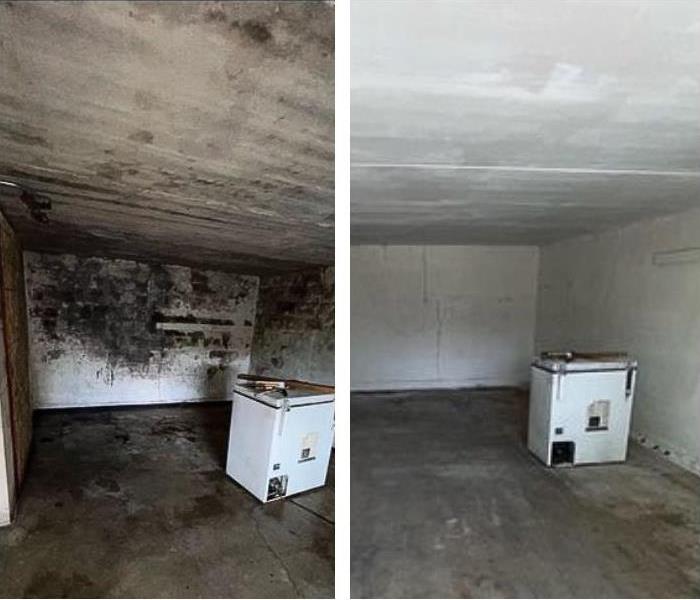 Before and after of the basement - "Like it Never Even Happened."
Before and after of the basement - "Like it Never Even Happened."
When a garage fire emerged, flames and smoke overtook the home. This home underwent quite extensive damage due to a fire that occurred and spread havoc all throughout the home. The aftermath of such a traumatic event called for swift and comprehensive action to mitigate further damage and begin the restoration process. SERVPRO®, armed with a team of skilled professionals and a wealth of experience, was ready to confront the challenges presented by this fire-damaged home.
THERE'S A PRO
Our recent fire job involved a meticulous process to restore the affected property. To begin, we carefully inventoried the kitchen, packed up cleanable fabrics, and thoroughly cleaned the bedroom floor and walls. Moving forward, our team continued packing contents while completing the main-level inventory. We then disposed of unsalvageable items and prepared bed frames, box springs, and the dining room table for removal. Prioritizing documentation, we carefully recorded and disposed of basement contents, followed by the necessary demolition work in the basement area.
Ensuring the protection of your belongings is always a top priority for our team. In this case, we sealed doorways, covered furniture, and took precautions to safeguard kitchen cabinets and countertops. We also relocated the stove and selected kitchen items to the sunroom. Additionally, we HEPA vacuumed, thoroughly disinfected, and meticulously cleaned the exposed backside of the walls. The bedroom received attention as well, with the removal of carpets and pads from the steps.
The basement and garage underwent media blasting, comprehensive cleanup, and a fresh coat of paint to bring them back to their former state. Pressure washing was carried out to thoroughly cleanse both areas. These actions represent just a glimpse of the extensive work required to restore the home to its previous glory. Finally, as one of the last steps, our team diligently sponged and wet-washed walls, fixtures, windows, and doors, ensuring a thorough cleaning process throughout the property
Fact or Fiction?
9/20/2022 (Permalink)
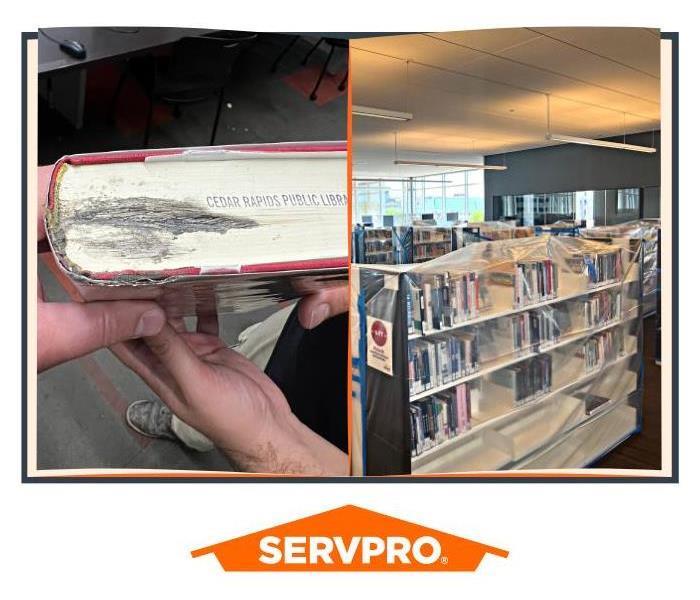 When help is needed, SERVPRO is there!
When help is needed, SERVPRO is there!
SERVPRO understands the craft of storytelling. Within the work that we do every day, we see a lot of beginnings, middles, and end results. The Cedar Rapids Library knows the art of this as well, as their 95,000 sq. ft. library holds thousands of novels and story books. So when fire damage became a villain in their story, SERVPRO was ready to step in and help get them to a happy ending.
When our Franchise Owner, Scott, got the call from the Cedar Rapids SERVPRO that a fire had occurred, there was no hesitation in being there to help. After all, SERVPRO has coined the term "Here to Help" and used it consistently, and we stand by our word.
Scott himself, along with other members of our team drove to Cedar Rapids in the past weeks to pitch in and help with the restoration process. There was a lot of care, attention to detail, and dedication that went into being a protagonist in this process.
A Lesson from Smokey the Bear
8/15/2022 (Permalink)
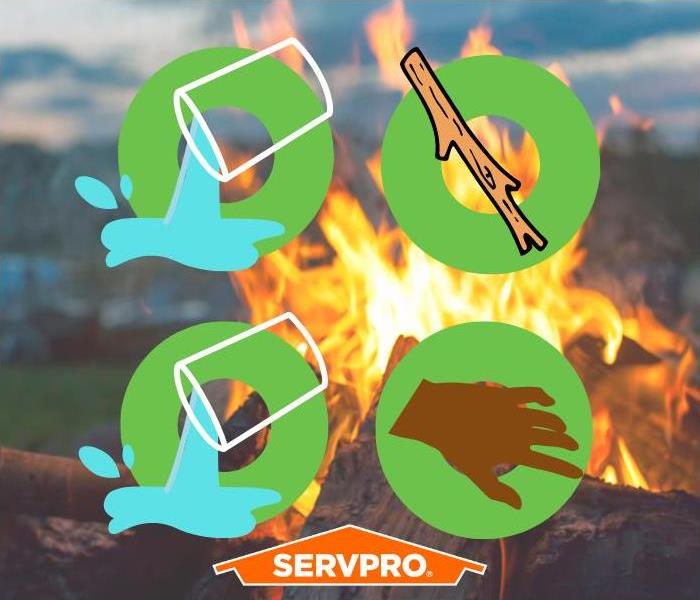 Just 4 steps to ensure safety!
Just 4 steps to ensure safety!
Campfires often bring family and friends together for music, laughter, and good conversation. There is something about bonding over the orange flickering light and roasting marshmallows that just feels so perfect in the summertime!
When a campfire is not properly put out there is potential for forest fires, putting animals, people, and homes in danger. Nobody wants to end a wonderful night of sitting by the fire, looking out across a field that is up in flames.
Our suggestion to put this possibility at bay is quite simple and has been one of Smokey the Bear's most significant missions for countless years! Knowing the way to properly put out a bonfire is key!
If you can remember these steps, you'll always be prepared to keep forest fires at bay:
Drown, mix, drown, feel!
- Drown: once the fire has mostly burnt out, pour lots of water on the fire Drown ALL The embers, pouring until this hissing sound stops!
- Mix: mix all the embers and ashes- Using soil or sand will enhance this step
- Drown: pour more water onto the fire and ensure it is all moist.
- Feel: carefully feel the fire to make sure there is absolutely no heat coming from the remnants.
Following these steps will help to keep you and your surroundings safe
Keep Your Neighbors Safe on National BBQ Month
5/11/2022 (Permalink)
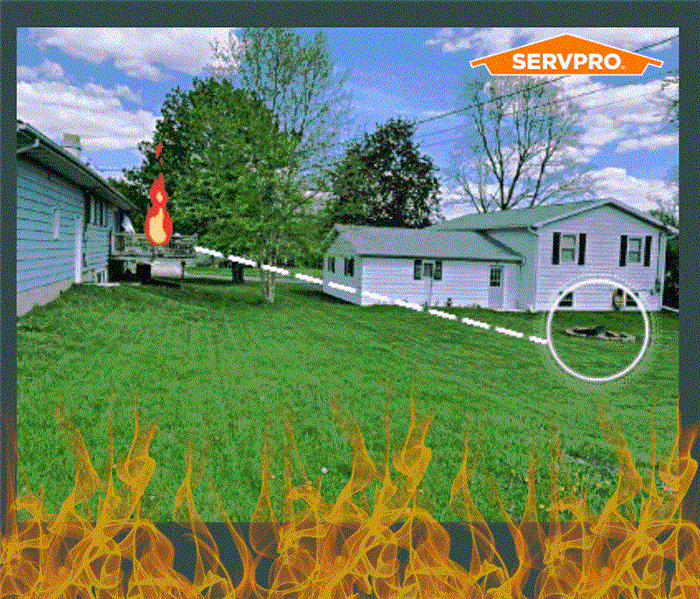 The firepit and the neighbor's deck that caught fire
The firepit and the neighbor's deck that caught fire
On National BBQ Month, SERVPRO would like to remind you to invite your neighbors over for the cookout, rather than bringing the flames to them.
When it comes to safety and fire prevention, here at SERVPRO we have learned that precautions and prevention are not for just your own safety, they're also for your neighbors! We worked on a job where the fire damage to a house was caused by a neighbor's fire pit. Gusts of wind picked up debris from their fire pit and I think you can see where this is going. The neighbor's deck caught fire causing damage to a number of rooms and smoke odor throughout the home. They never thought that a 'harmless' fire pit fire could get so out of control and end up causing damage to a property that was not their own.
The safety of you, your family, and your neighbors is something to take seriously! When you are having a BBQ, bonfire, or any other kind of open flame during this spring/summer season, we urge you to practice the fire safety that we all know but don't always practice.
If you need a refresher on some important fire safety, here is a great resource:
Beware of Carbon Monoxide Poisoning
4/24/2022 (Permalink)
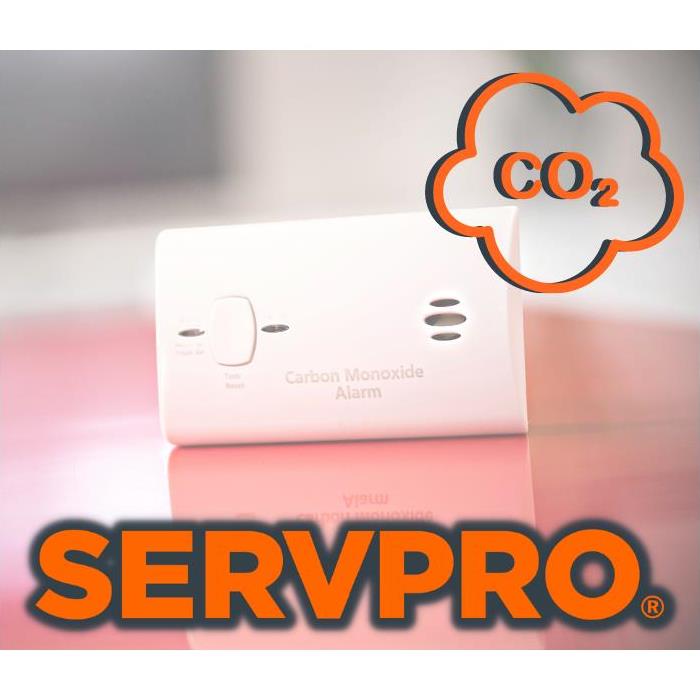 Test your CO2 alarm now!
Test your CO2 alarm now!
Don’t ignore the beeping sound of your smoke or carbon monoxide alarm.
Yes. We are talking to you, the person who has justified the sound to low batteries. Admittingly, that has been me. It could be low batteries but don't take that risk. Do you know that besides water and fire disasters, we also have cleaned after TRAUMA disasters related to CO poisoning? Death by carbon monoxide is tragic and traumatic for anyone involved. What’s worst is that carbon monoxide is an invisible, tasteless, and odorless gas so there are no alarming indicators to alert you naturally and right away.
Here are a few tips to make sure you and your family are safe in your home.
- Test your Carbon Monoxide Alarm monthly.
- Install CO alarms on the outside of bedrooms and on each floor including the basement.
- Invest in a Plug-in with Battery Backup CO Alarm.
- First Alert recommends replacing CO alarms every 5-7 years.
- If the alarm goes off, quickly go outside and call 9-1-1.
Household items that produce CO.
It is important to do a maintenance check-up on heating sources such as the furnace, generators, stove, oven, dryer, and chimneys to ensure everything is working properly. Changing filters on your equipment will help it be more efficient and safer. In addition, do not leave your car running in an enclosed space even if you are just heating up the car before traveling especially if it’s the enclosed space is an attached garage.
P.S. If you visiting a family or friend overnight and they are ignoring a beeping CO alarm, DO NOT STAY THERE.
We are here to help PREVENT disasters. Disaster will always happen and although we are good at restoring homes and content, we can’t restore someone's passing. That’s why it’s important for us to share safety tips and bring awareness to topics such as these. Be safe.
More Resources: 6 Things to Know About Carbon Monoxide Alarms.
Do You Have a Fire Plan?
12/29/2021 (Permalink)
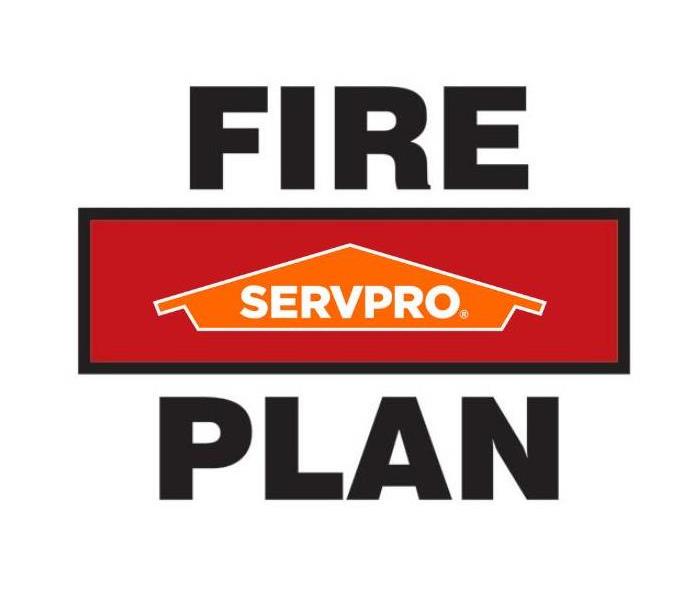 Do yourself a favor and have a plan in place!
Do yourself a favor and have a plan in place!
If you have ever seen the show This is Us on ABC you’ve got a look into how devastating it can be for your home to go up in flames. Maybe you have witnessed it happen to a loved one, or you have experienced it yourself. Either way, we want to protect you from this happening to you or your family, and if it does, we want to help you be prepared.
While we know it is not always 100% preventable, things happen, there are many ways that you can lessen the odds. In this fictional show, the house fire was caused by a faulty wire from the couple’s crockpot. This brings us to our first tip: ALWAYS unplug appliances when not in use.
Have a Plan Set & Educate your Children
Though there is a long list of precautions you can take, one of the most important actions necessary when it comes to fire safety is making sure you have a plan in place in case of an emergency. When I was little my bedroom was at the top of a three-story home. My parents kept a fire escape ladder under my bed and told me that it was to be used in the event of a fire so we could get out safely. This is great, but go even further! Teach your kids your fire plan and then show them how to properly execute it! Running drills can only further your preparedness and in turn, keep you much safer!
Click here for some fun resources on fire safety with kids, and as always call SERVPRO of Black Hawk County for your clean up needs!
Safety During the Holidays
12/21/2021 (Permalink)
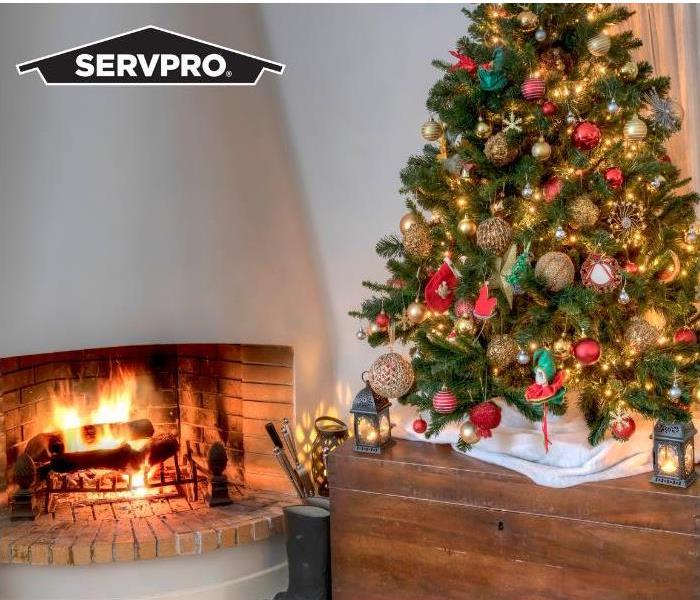 Peace, love, and safety!
Peace, love, and safety!
It’s that time of the year where chestnuts roast on open fires and Christmas trees are lit up providing extra holiday cheer. While the holidays are a great time for lights, warmth, and other festive things, this can sometimes be hazardous.
CELEBRATE SAFELY
While we want you to all celebrate this holiday with all the pizzaz, we also want you to be safe. Here are some good guidelines to keep in mind when getting holly and jolly!
- Keep all decorations at least 3 feet away from heat sources
- always unplug your Christmas tree before you leave the house or go to bed
- If you have a real tree, make sure to water it to keep it hydrated and safe
- Inspect your fireplace and make sure it is working properly before use
- Check lights and other electrical decorations for shortages or broken wires
- Only plug in Christmas lights in dry areas
WRAPPING IT UP
We hope that your holidays are safe and Merry, but if disaster creeps its way into your festivities, call SERVPRO so we can help you get back to your celebration and loved ones.
BE-etle Smart and Check your Chimney
10/29/2021 (Permalink)
Pests making themselves at home in your house is something no homeowner wants to deal with. What’s even worse, is when those critters end up causing damage to your home. They can be hiding in the most unique places.
BEETLE BUILD UP
Pests making themselves at home in your house is something no homeowner wants to deal with. What’s even worse, is when those critters end up causing damage to your home. They can be hiding in the most unique places.
JUST DO IT, CHECK YOUR CHIMNEY
The National Fire Protection Association recommends a yearly inspection by a qualified professional. This could help prevent pests from making your chimney their home! In addition to yearly inspections, if you ever suspect that your chimney needs attention, you can also follow these steps to do a self-evaluation.
-Check for any cracked brick or structural issues
-Notice any changes in wood-burning speed
-Check for smoke smell when the burner is not lit
- Use a mirror and a light to look for any obstructions
All in all, it is important to keep your fireplace and chimney functioning properly, this could also help prevent pests from making your chimney their home! If you are ever second-guessing, call a professional to do an inspection, and if something gets missed and you have a mess on your hands due to fire or smoke damage, call SERVPRO! We are here to help!
Space Heaters- What you Need to Know
9/27/2021 (Permalink)
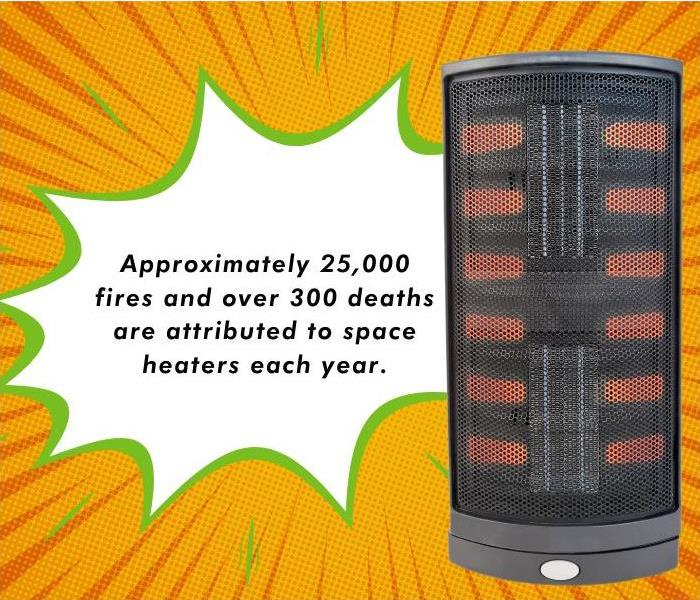 Know the facts!
Know the facts!
The leaves are beginning to change, the air is crisp, and trips to the pumpkin patch are just about in full swing. Fall is officially here and wrapping up in a blanket with a warm beverage is a great way to stay warm. Another tactic to stay cozy is using a space heater. Space heaters may be a great source in keeping you warm but they can also be the source of a fire if not properly used.
Get Cozy...Safely
If you find yourself longing to warm up via space heater, follow these safety tips to ensure that your comfy, relaxing time doesn’t end up being a burning hot disaster!
- Keep your heater 3 feet away from flammable objects
- Set the heater on a level surface
- Never leave it running unattended
- Always plug your space heater into the wall -- NOT a power strip
- Look for a safety-approved heater
- Purchase a space heater with an automatic shut off
- Make sure your fire alarms are working properly
There you have it! By following these tips, you are able to enjoy that nice warm flow of heat all while keeping yourself safe!
We know sometimes things still happen despite your best efforts, so if all things go astray, don’t hesitate to call SERVPRO of Black Hawk County so we can get it back to "Like it never even happened."
The Cat’s Out of The Bag- Pets and Candles Don’t Mix
8/17/2021 (Permalink)
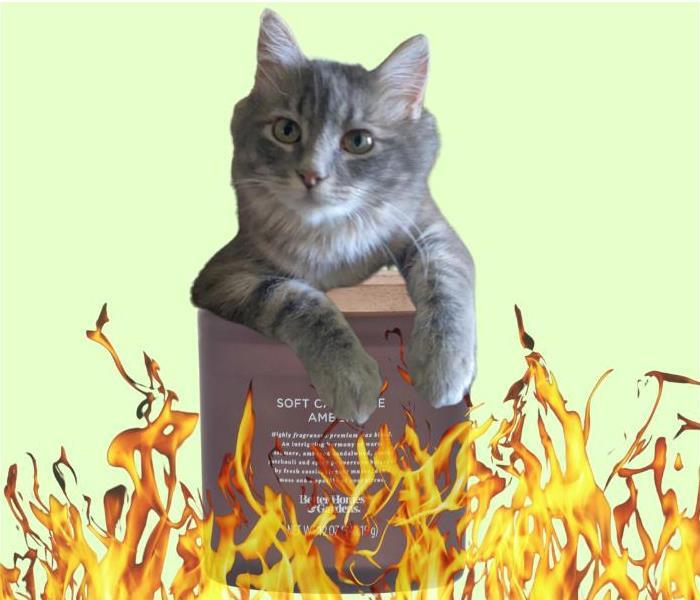 It's not something you see every day...
It's not something you see every day...
Picture this: you are snuggled in your living room with your friends after a long day of work. The TV is on and there is a candle lit on the coffee table RIGHT where you can see it for comfort. It seems like having the open flame directly before your eyes would make it safe to enjoy the ambiance of a softly lit candle. That is probably what we were all thinking before things went terribly wrong.
THE PURRRFECT DISASTER
I got my cat Pepper back in February of 2021, though sweet and cuddly, she is curious and loves to cause mischief. They do say curiosity killed the cat… Thankfully she is alive and happy as can be, her tail however, let’s just say it’s not as fluffy and silky soft as it once was.
While we were mid-episode, Pepper jumped up on the coffee table, as cats do. As we know, the candle, Soft Cashmere Amber, to be exact, had also made its home on that same table. Pepper, who I tend to call my “dog cat”, due to her excessive tail wagging, wagged her tail… you guessed it, RIGHT OVER the burning flame of the candle. If you are familiar with how a sparkler on the fourth of July lights up, just imagine that except the screaming and laughter from little children was replaced with the screaming of three very concerned and shocked roommates. Pepper ran, jumped, and hit the floor (a stop, drop, and roll, if you will) causing her tail to miraculously extinguish.
THE AFTERMATH
When all was said and done, what we were left with was a very unpleasant smell in our house for a couple of days, and one tail with a limited amount of char. Two things that we gladly took, over what the alternative could have been. A little bit of brushing and some cuddles made Pepper good as new
THE LESSON
Sometimes things can go wrong right in front of your eyes, which makes it even more inevitable that disaster can strike at any time and you might not be there to put the flame out in the moment.
In the U.S. alone, candles cause roughly 8,000 home fires. Additionally, candle fires have cause approximately 80 deaths and 700 injuries each year. This number seems to grow rapidly each year.
Keep yourself and your furry friends safe by avoiding burning candles in your home. If you can’t give up that delicate light and fresh smell, follow these tips to avoid becoming a statistic:
- Never leave an open flame unattended
- Make sure that the candle is completely out before leaving your home
- Burn your candle far away from anything that can catch fire, including but not limited to: curtains, towels, blankets, bedding, carpet, books, and furniture
- Make sure children and pets cannot reach the candle
- Never move or touch a candle when it is lit
HERE TO HELP
In the event that your best efforts are not enough to keep your home (or pets) from going up in flames, SERVPRO is readily available to help! We have highly trained technicians who have the heart and skill for cleaning up after a disaster, no matter the size!
Plant Combust on deck and sparks catches house on fire.
5/17/2021 (Permalink)
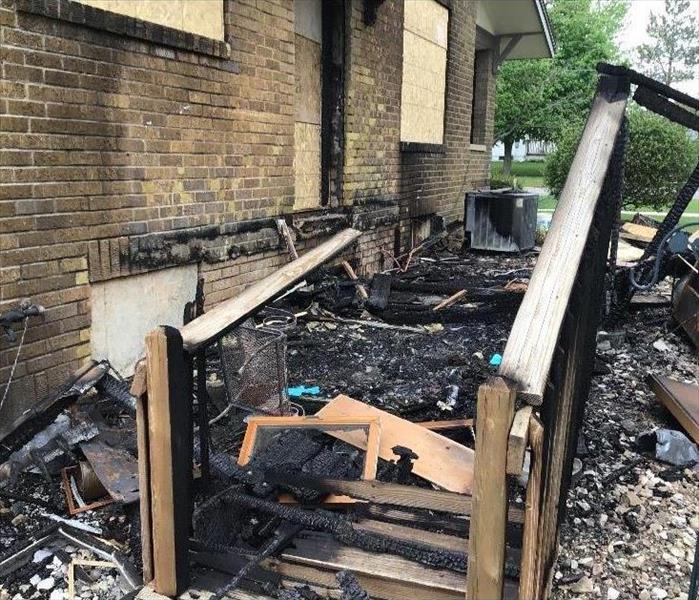 Home insurance may cover the cost of fire damage.
Home insurance may cover the cost of fire damage.
We are currently working on an uncommon fire loss. Last Sunday, a deck caught on fire after a flower pot spontaneously combusted. The fire investigation is still taking place but the plant food or fertilizer seems to be the culprit. While it is usually safe to use these products for your plants, too many variables such as temperature, placement of kindling, all lined up “just right” to combust and start a fire.
Some propane tanks were located nearby and exploded when the fire spread, making matters worse. The fire destroyed the deck and continued to spread to the side of the house, attic, kitchen, and dining room. There is smoke damage all throughout the home.
Unfortunately, the fire damage was so severe that the home will have to go all the way down to the studs. SERVPRO of Black Hawk County is working hard to remove all the affected content as well as demolishing damaged walls and built-ins to dispose of. Our crew will continue to clear out the home, clean the smoke, soot, and fire ruins. Removing the smoke odor will also be a priority.
A lot of this homeowner’s contents were nonsalvageable but some old heirlooms will be cleaned and stored away until their home is restored.
Sometimes, disasters just happen.
Be Red Cross Ready for a House Fire
5/12/2021 (Permalink)
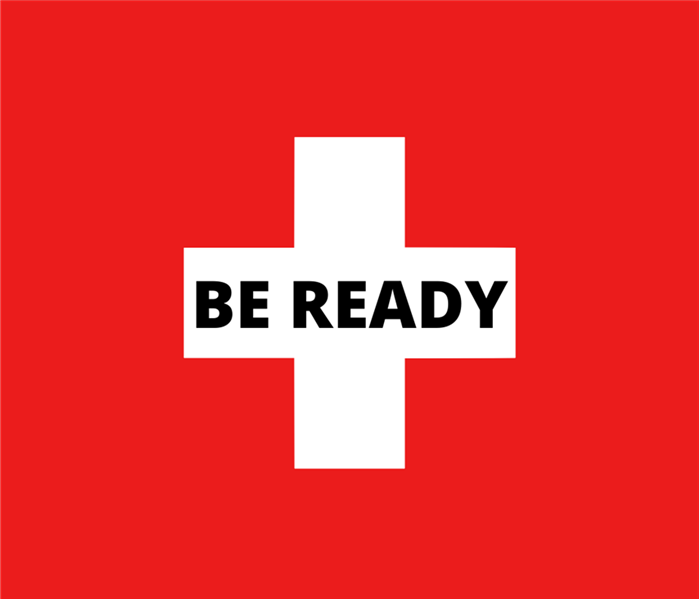 Be Prepared and Ready for a Fire.
Be Prepared and Ready for a Fire.
We had the opportunity to join a video call with the Regional Red Cross team for a monthly update. In this meeting, Red Cross leaders shared activities in the field, celebrated volunteers, and encouraged all participants to share safety tips to prevent a fire disaster. Today, an ex-firefighter who now volunteers for the American Red Cross presented a slideshow of how to be RED CROSS READY DURING A FIRE.
It was a great presentation with really important tips to keep yourself and your family prepared and safe from a fire. Here’s what stood out the most for us.
5 Tips to be RED CROSS READY
- Always supervise your cooking. (About 50% of fires start in the kitchen.)
- Keep flammable objects away from any heat source.
- If you smoke, avoid smoking in bed or when you are drowsy.
- Put your lighters and matches in a protected place, away from children.
- Make sure your smoke alarms are working properly.
We clean and restore homes and businesses after a devastating fire. Although fire restoration is our business, your safety is what is most important! We appreciate all that American Red Cross does to ensure family safety and empower preparedness.
Practice an Escape Plan
Nevertheless, accidents and disasters happen even after doing all the right things. In the case that a fire occurs, make sure you have an escape plan and communicate it to the whole family, especially the children. Check out these great resources, Home Fire Safety Checklist and Home Fire Escape Plan.
Here to help.
House Fires aren’t fun. 10 Tips to keep your Summer Fun.
5/10/2021 (Permalink)
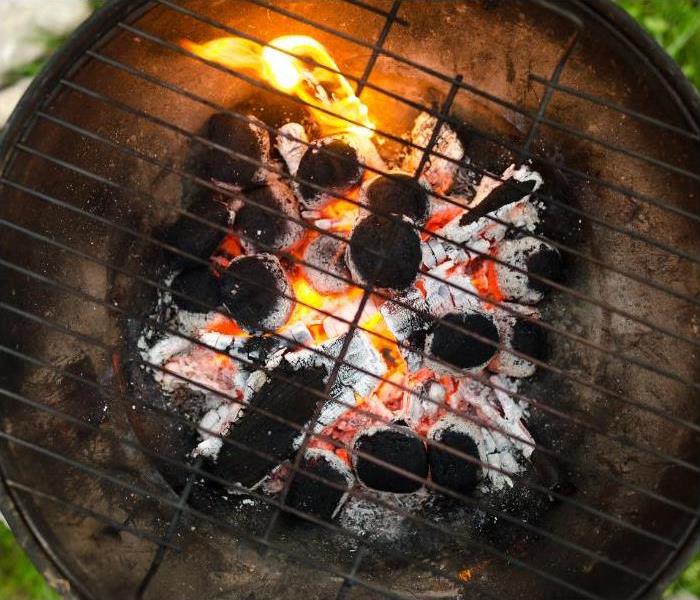 Do not leave any fire unattended.
Do not leave any fire unattended.
As outdoor activities start to be in full swing, SERVPRO of Black Hawk County wants to share a few tips on how to prevent a fire disaster on your property.
- Do not grill or smoke meats indoors.
- Keep the grill at least 10 feet away from your home or garage.
- Ensure there are no trees or other overhangs near the grill, firepit, or tiki torches.
- Keep a bucket full of water nearby or a fire extinguisher.
- Do not use water for tiki torch fires. Snuff out the flame. In the event that it is an unmanageable size, use a fire extinguisher.
- Do not leave your fire or grill unattended.
- Do not light your fire pit if it’s windy outside.
- Saturate the embers from a fire pit with water and cover it up with a metal top.
- Keep all flammable things away from any fires or heat source.
- If smoking cigarettes or cigars, make sure you put it out all the way and put water on it before throwing it into the trash.
We are ready for warmer days and, as we start feeling more confident to be with larger groups, to enjoy people’s company safely. Share these tips with a friend or family member so that they may also stay safe this summer.
Saving Grandma’s Wedding Dress
12/30/2020 (Permalink)
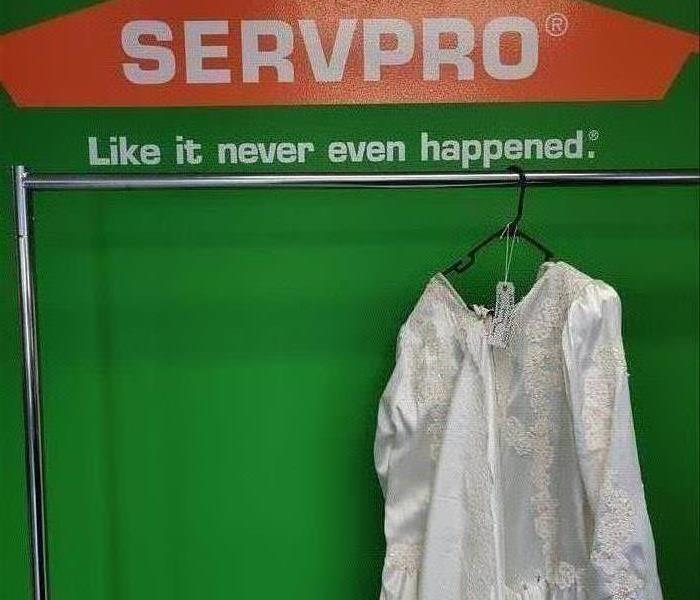 Preserving Cherished Treasures.
Preserving Cherished Treasures.
A few weeks ago, SERVPRO of Black Hawk County had the opportunity to remove a musty smell, along with smoke odor, from a wedding dress. The woman, Madison, came to us saddened after other attempts to clean it failed. The wedding dress was an heirloom from her grandmother, that had been passed down. Brought to us in a black plastic bag; it seemed like an impossible feat to restore!
Here to help
Empathizing with Madison, we prepared our plan to save the precious dress. The small house fire they recently experienced revealed items tucked away for safekeeping had been affected. The smoke from the fire found itself inside the closet where the dress was stored. After most house fires, the homeowner not only has fire damage but often water damage from putting out the fire. Humidity that builds up could have dampened the room as well, causing more damage. Out of the garbage bag and onto a dress hanger, to a portable rack was the first step to recovery. Wheeled to the confined bay area, the dress was relocated and the room prepped for ozone treatment.
What is “ozone-ing”?
SERVPRO utilizes ozone machines to generate a gas called Ozone that is very reactive. The ozone molecules are made up of three oxygen atoms with the third atom being able to detach and attach itself to other surrounding molecules, including smelly ones! Most often, “ozoned” items no longer have an odor. OZONE IS DANGEROUS to breathe in. That’s why we take precautions and use a sealed room to contain the manmade concentrated gas. A caution/warning sign on the door communicates the importance of staying out while the machine runs. When the ozone machine is turned off, we keep the doors closed for at least 24 hours. Then we open the room up and air it out.
BYE SMOKE ODOR
We returned the keepsake wedding dress to Madison the following week, absent of any smoke or musty odor! Our team of cleaning technicians especially enjoys restoring an item with significant meaning for a person AND in this case, future family members, being able to continue handing down the heirloom piece. Don’t give up when you have experienced odor damage to a beloved item, give us a call! We will tackle it to our very best ability.
Learn more about Ozone:
https://www.SERVPROblackhawkcounty.com/blog/post/235159/commercial/true-or-false-ozone-effectively-kills-viruses-and-bleaches-the-air
https://www.washingtonpost.com/lifestyle/home/its-tough-to-get-rid-of-cigarette-smells-but-an-ozone-treatment-can-do-it/2018/11/11/e0d64dfa-dedc-11e8-85df-7a6b4d25cfbb_story.html
Chimneys are pretty… dangerous.
12/23/2020 (Permalink)
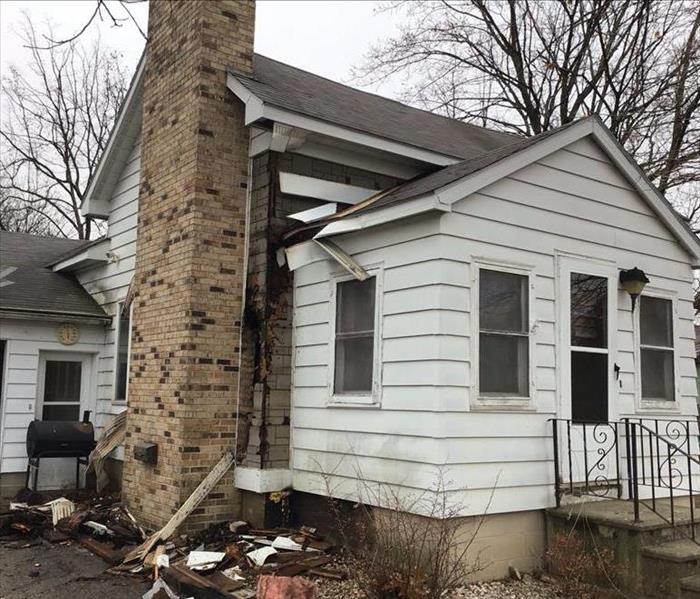 Annual Inspection of your chimney can prevent a fire.
Annual Inspection of your chimney can prevent a fire.
*sings
Chim chiminey
Chim chiminey
Chim chim cher-ee! A sweep is as NEEDED
As NEEDED can be
The look of a chimney and the sound of crackling wood is indeed pretty to look and listen to but did you know that without proper maintenance and cleaning, chimneys can be hazardous. As a restoration business that cleans up after fire damage, we have already had a few fire losses due to chimneys. With colder temperatures, we assume most of you have started up your fireplace and hopefully, nothing has happened but it’s not too late for some education!
6 Tips to maintain the health of your chimney
- Have a professional do a chimney inspection annually – the best time is off-season (before fall and winter).
- Observe your chimney draft. The chimney should draw the fire up rather than push back inside your home. You can test this by lighting a rolled-up newspaper or small pieces of wood inside the chimney. If you see that it doesn’t smoke properly and fills the room, quickly distinguish the flame. There could be an obstruction in your chimney that needs to be cleared away. Be sure to always open the damper before lighting your chimney.
- Do not use unseasoned wood in your fireplace. Unseasoned wood or “green wood” is wood that is still wet. Unseasoned wood will smoke harshly and can create more soot and creosote. Creosote is a residue of wood burning in the chimney but too much can be extremely flammable. According to the Chimney Safety Institute of America (CSIA), “All forms are highly combustible. If it builds up in sufficient quantities – and the internal flue temperature is high enough – the result could be a chimney fire.”
- If you have a brick or masonry chimney, inspect the interior of the firebox and exterior of it for any holes, loose debris, or cracking in the mortar. Fire can escape from these cracks and spread to the rest of your home. Also, check for creosote or soot build-up. If the creosote is tar-like, do not light a fire. You must get the chimney cleaned out.
- If you are a new owner to a chimney, understanding the mechanics and build of your chimney will help you prevent a fire. Before you purchase, make sure you ask a lot of questions about the proper way to maintain the chimney and even how old it is and when was the last time it was repaired or had a maintenance check. The diynetwork.com has a great article with easily consumable information about the Fireplace and Chimney Elements.
- With a glove, check the smoke shelf for any debris, leaves, or water that could have fallen through the chimney cap. It is important to have a cap on the top of your chimney to prevent large objects or animals to come in through your chimney. Sorry Santa, you might need to come in through the front door.
Enjoy your clean and safe fireplace!
We do not sweep chimneys but we do clean soot and fire damage. Remember, you should schedule an annual inspection preferable performed by a CSIA Certified Chimney Sweep in 2021. If you experience some fire damage and need your fireplace restored, give us a call. We are here to help.
BEWARE of 10 Things That Can Start a House Fire.
9/28/2020 (Permalink)
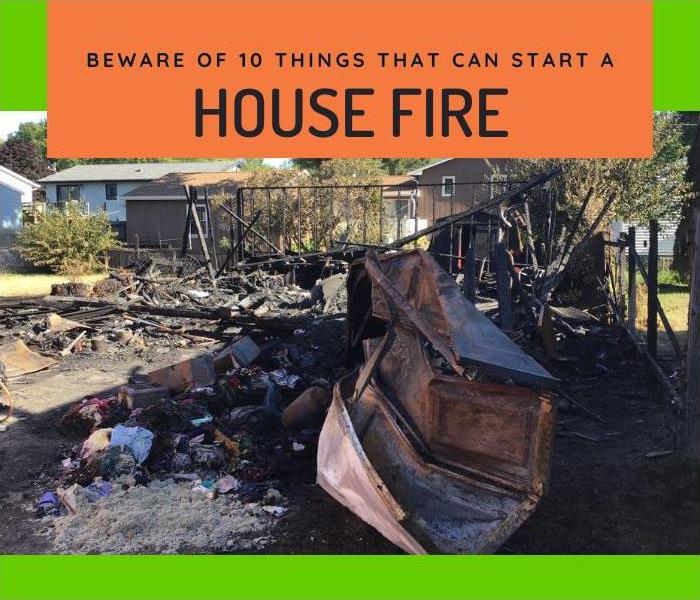 Fire Prevention week is Oct 4th- Oct 10th. Visit NFPA.org for more info.
Fire Prevention week is Oct 4th- Oct 10th. Visit NFPA.org for more info.
Fall is in full swing so you know what that means? Pumpkin Spice Lattes, Pumpkin Patches, Apple picking, Apple Cider, Pumpkin or Cinnamon scented candles, and all your favorite things about Fall. It’s important to mention that it’s also when the risks for fire in your home can increase because of the upcoming Holiday season. Fire Prevention Week (FPW) is on October 4th – October 10th so we are going to share 10 Things that may cause something just as scary as any of your Halloween costumes this year. HOUSE FIRES.
- Candles – Candles can help create a cozy, mysterious, or romantic atmosphere but don’t let a fire kill the vibe. If you are going to light a candle, do not leave it unattended, put it away from anything flammable and keep it out of reach from your children and pets. We are pro-battery-powered candles. They might not smell Fall-ish but they look just as great!
- Space Heater – If you want to save costs from turning up the furnace and heating the whole house, a space heater might be a good way to do just that. Still, you will have to practice some safety measures. Make sure the wires are healthy, do not plug it into extension cords only directly into an outlet, place it at least 3ft away from anything flammable, do not put anything over the heater, and turn it off and unplug it every time it’s not in use.
- Heating Pad/ Blanket – There is something so great about sleeping with a heated blanket on a cold fall/winter night. Make sure that you connect it directly to an outlet. It’s important to inspect the wires. If it’s damaged, do not use it. Also, make sure that it’s connected properly to the blanket or pad. Turn off and unplug after every use.
- Electrical Cords – Please inspect the wires of all your electrical devices and appliances. Damaged cords can spark up. If you bought or inherited an antique appliance, we advise that you take it to a certified professional who can rewire it, possibly test it and certified for a UL certification (safety organization).
- Fireplaces – Chimneys and fireplaces are a magical thing but so are fire breathing dragons… do you want that in your house? Actually, I would because it’s cool but I definitely don’t want my house to catch on fire. Fireplaces in your home are great but please take safety measures. Before you light up the chimney this season, have a chimney inspection.
- Stove and Oven - This year’s FPW focus is on Kitchen Safety. According to NFPA (National Fire Protection Association), “Cooking is the #1 cause of home fires and home fire injuries.” Do not leave unattended and definitely set a timer for when food is ready or a reminder that you’re cooking.
- Sawdust – Is your husband overtaking your garage because he started a woodworking business during quarantine? Well, you better tell him that he needs to clean up all that sawdust because it’s actually flammable. This might help you keep a tidier and safer workshop.
- Dryer Lint – It is extremely important to clean your lint filter before and after you use your dryer. The heat from the dryer can spark lint on fire and lint is extremely flammable. Dryer vent ductwork should be cleaned out at least every year. Here’s an eye-widening fact from the S Fire Administation, “2,900 home clothes dryer fires are reported each year and can cause an average of 5 deaths, 100 injuries, and $35 million in property loss.”
- Smoking – If you’re a smoker, please smoke cigars, cigarettes, or pipes outside of your home. It is going to be safer that way. Stay alert as you smoke and do not smoke while drowsy or sleepy. Make sure you completely put out the cigarettes in an ashtray or bucket with sand. If you are going to throw ashes away in the trash, put water over it and make sure the ashes are cool. For more safety information, download this Smokers Safety Sheet.
- Grill – The temperature is still nice enough to grill. Remember to always place your grill away from your home or garage. You should not put your grill in your garage or under any porch. Do not leave it unattended and always have a bucket of wire nearby. Store paper towels or cloth towels away from all hot surfaces.
As a restoration company, we clean up after many fire-related disasters and we see how it affects homes and families. We really encourage you to be alert when using any of these items.
Need help figuring out what to do with your home after a fire? Call your Insurance agent and then call us! We can help restore your home “Like it never even happened.”
HERE TO HELP.
Ways to Prevent Fire from Toasters.
8/3/2020 (Permalink)
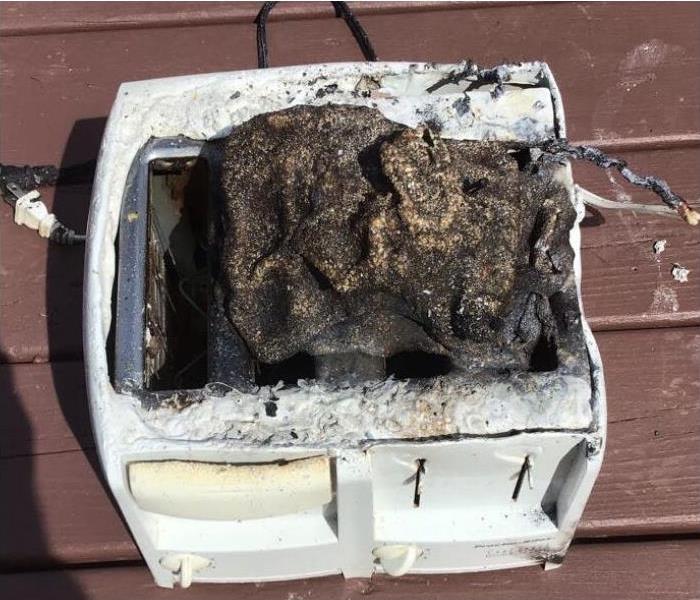 Toast your bread, not your home.
Toast your bread, not your home.
Don’t be Toast because of Toast.
A regular morning routine of putting white bread in the toaster might turn into an unexpected fire inside your house. It is possible to accidentally start a fire when using what seems to be a fairly harmless kitchen appliance. Just recently, SERVPRO responded to a call about a house fire and the cause of loss was a rag that was near a toaster! Let’s go over a few safety tips to avoid a fire from your toaster.
5 Ways to Prevent Toaster Fires
- When choosing a toaster, read up on reviews and check for recalls. Some brands of toaster may have a history of fire-starting issues.
- Make sure there is nothing flammable near your toaster such as paper towels, curtains or rags.
- Regularly clean your toaster from breads crumbs and any grease or dirt residue.
- Keep your toaster unplugged when not in use and inspect the health of its cords. Do not ever plug in an electrical appliance that has frayed wires.
- Stay near the toaster when using it. Depending on how brown you want your toast, it will only take about 2-3 minutes of your time that can easily fly by. Just pull out your phone and watch a YouTube video on Toasters catching Fire while waiting.
BONUS SAFETY TIP - GET A FIRE EXTINGUISHER FOR YOUR KITCHEN!
We restore and clean up after fires. If you experienced an unfortunate fire disaster, we are here to help. Call us at 319-268-1521.
There’s Grease Build-up in your Kitchen.
8/3/2020 (Permalink)
 You might have grease in high places.
You might have grease in high places.
Do you know that you may have grease on surfaces you’re not aware of? Personally, my kitchen is very small and I do not have an overhead exhaust. I also do not do a lot of cooking but my husband on the other hand could be a professional chef. He loves cooking and I like a clean home. I’ve been avoiding the kitchen because I have noticed things that I wanted to ignore such as grime on the stove plates, burnt trays in the oven, and smoke stains crawling upward from the stove to our wall…. So, my husband cooks amazing but leaves a scary kitchen. It’s a fair trade-off… Anyway, I was going to continue to ignore it until one day, I looked up towards the ceiling fan and saw a thick layer of dust on each blade. I could not tame the urge to wipe it away so I grabbed a small ladder and climbed up with a microfiber towel in one hand, and a multipurpose cleaner in the other. I thought this would be an easy, easy, easy clean. Just a swipe of my towel on the blade would pick up all the dust but instead, it felt as if my towel was wiping a thick layer of honey. It wasn’t honey though; it was grease! The dust was stuck on the grease and worse yet, since I was on that ladder, I saw several other surfaces that had that same yellow yuck on it. I was overwhelmed so I ran away into my living room which is much cleaner.
Apparently, oil in a hot pan will evaporate into oil vapors that will travel through the air until it cools down and stick to the surfaces of your kitchen.
This week’s cleaning chore is deep cleaning my kitchen. I haven’t cleaned it off yet, not because I’m ignoring it (it’s way too much to ignore right now especially being an employee of SERVPRO - THE Cleaning PROS!), but I’m researching the best way to approach this. Below I provided some links to a few of my good internet finds. Plan A is to try one of these natural home remedies but if that’s not heavy duty enough to remove possibly a years’ worth of grease, I’m turning to our SERVPRO Orange Plus cleaner. This cleaner cuts through soot, dirt, and grease! Plus, it smells fantastic.
SERVPRO of Black Hawk County has had its fair share of cleaning commercial and residential kitchens.
Need Professional cleaning? Call us at (319) 268-1521.
By Dani Liu
Helpful Links
How to Clean Grease off Most Common Kitchen Surfaces – Taste of Home
How to Clean Greasy Kitchen Walls, Backsplashes, and Cupboards – kitchen
How to Clean a Ceiling Fan: The Greasy, The Dirty, and The Dusty -Del Mar Fans
Grill Fires are the highest in July.
7/16/2020 (Permalink)
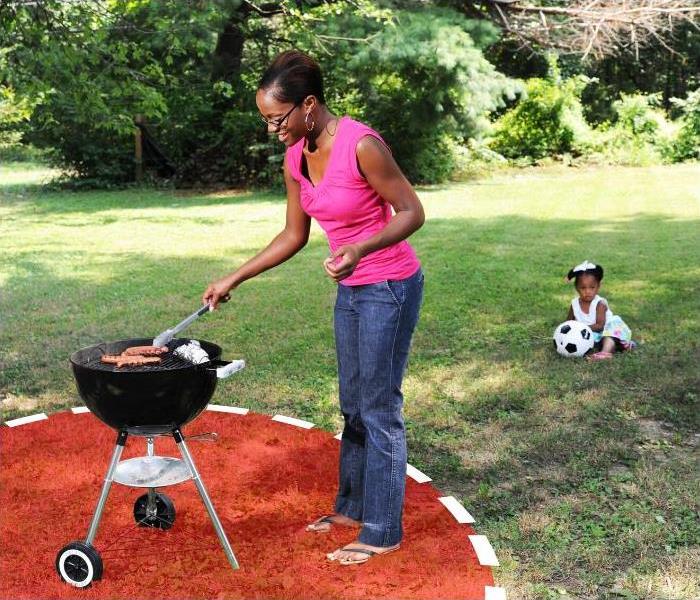 Keep children and pets at least three feet away from the grill area. (Credit:National Fire Protection Association)
Keep children and pets at least three feet away from the grill area. (Credit:National Fire Protection Association)
It is summertime and we are taking advantage of the weather by spending as much of it outside as we can. One outdoor activity we Iowans enjoy is grilling or smoking meats. There’s nothing like beautiful grill marks on steak, burger or hotdog to really stamp the summer season. We don’t want your summer to go up in smoke because of a nasty grill fire or grill caused injury so here are 5 ways to stay safe while grilling.
Here’s the Drill, Grill SAFE!
- Keep your grill at least 3 ft away from your house. Yes, that means NO GRILLING ON YOUR PORCH.
- Keep your grill away from anything that might catch fire such as outdoor umbrellas, cushions, garage, or dry plants.
- Keep your children and pets away from the grill and let your children know why.
- Do not leave your grill unattended when you’re cooking. This can save you from fire AND a burnt burger.
- Clean your grill from any left-over food and grease. Crumbs and fats can catch on fire.
Keep your grill clean.
Some of you may think that a dirty grill can actually make your food taste better but whether or not that’s true (it’s not!), we still recommend you clean it. It’s not just the grates you should clean but clean all the parts of the grill especially the main chamber where food and fats drop from the grates. In the long run, this will help with the longevity of your grill and prevent fires. Please take a look at the references for more information on grilling safety tips and how to clean a grill.
If you experience smoke or fire damage, give us a call. We can help.
References
Grilling safety - https://www.nfpa.org/grilling
How to Clean a Gas Grill - https://youtu.be/xmIQVDvkvZs
https://www.cnet.com/how-to/how-to-clean-your-grill-grill-grates-are-just-the-start/
https://www.realsimple.com/food-recipes/cooking-tips-techniques/grilling/grilling-food-safety
Home Alone! Helpful Home Safety Remedies For A Safe Summer.
5/12/2020 (Permalink)
With confirmed school closings, the uncertainty of summer programming, and the re-opening of work offices, some children will continue on their own at home. Prepare them well for a safe summer. These tips are a good reminder to ALL of us.
1,2,3, Home Safety Remedies
1.UNPLUG!
Reminders to UNPLUG certain appliances and equipment can prevent a fire.
Toasters, Toaster Ovens, Pizzazz, Keurig Machines- (hot cocoa use- not coffee, of course!) Unplug when the food is done, before consuming. Forgetfulness happens too soon once they sit down to eat.
Cell Phone Charger- It no secret that we are ALL using a lot more battery life these days. Phone chargers are moving up the list as a common cause of fires. When fully charged, unplug both the phone AND the charger from the wall.
Plus, unplugging these items can avoid any unwanted energy consumption- albeit small amounts of it.
2. STAY PUT!
Multi-tasking while preparing food won’t get them ahead here. Don’t walk away from appliances once started.
Microwave ovens and pre-set temperatures can be helpful, but should NOT be relied upon.
Children should be advised to wait at the microwave and use the sound/smell test when preparing packaged food. These items can be tricky in the description as defined for the recommended temperature button on the microwave, i.e. small vs regular-size popcorn. Remind them if an item is smelling burnt or has had the sudden ‘blop’ sound, hit off, and wait a few seconds before removing.
Plates, bowls, and cups- which one to use? Set out in a basket specific microwave-safe dishes and paper products for them to use. Avoid having other items around that they could grab. Styrofoam is highly flammable, literally taking seconds to ignite. (Unfortunately, I know this from experience). How often have we entered too much time to reheat an item? Equip them to use the right stuff and be ready to hit off if it smells or sounds done.
3.EXTRA, EXTRA, Read All About It…
Details of new chores should be written out and demonstrated. Being intuitive comes with age and experience. Understanding the reasons why sometimes are learned the hard way. It’s a lot to expect young people to have the knowledge we have gained through trial, error, and probably a mishap. Here are a few things you might be assigning and need to explain more:
- Removing & folding laundry- take out the collection in the lint trap of the dryer: It causes fire when it builds up.
- Vacuuming- NEVER pull with the cord to remove it. Use the plug ‘head’ to pull it out.
- Use of cleaning products: show them how to flush their eyes in case of accidental spraying, along with proper handling of rags when they are done. Hang outside separately.
(NEVER leave in a pile- combustible fires start this way!) - Garbage Can & trash bags-empty at the end of ‘their’ day, or set a specific time like right before you come home. Define full: items are all the way to the top. It seems obvious, but we all see things differently.
We hope this helps prevent an unfortunate disaster.
If you fire or water damage restoration, please call 319.268.1521
Fire Extinguishers and How to use it.
1/2/2020 (Permalink)
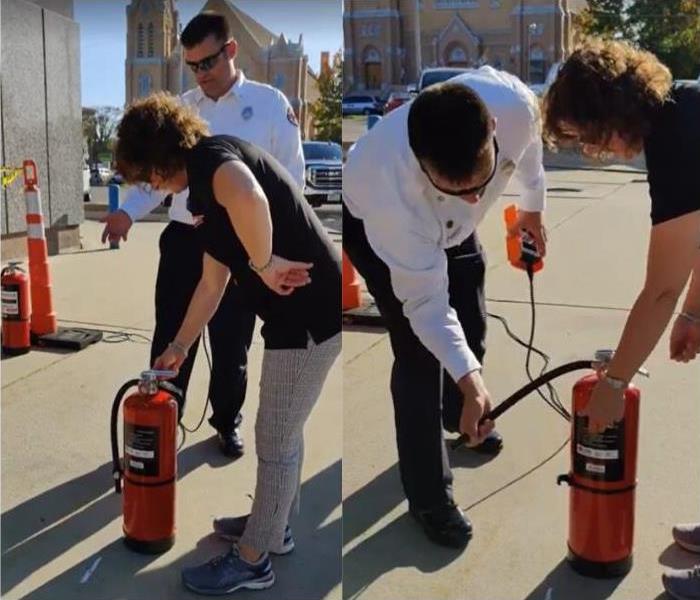 Team member Debbie learns how to P.A.S.S a fire extinguisher at the Waterloo Fire Department's open house.
Team member Debbie learns how to P.A.S.S a fire extinguisher at the Waterloo Fire Department's open house.
A friend and local insurance agent recently told us about how he had to use a fire extinguisher for a fire that started behind a wall. He was working on a do it yourself project in the bathroom and was soldering two copper pipes together which created a small rumbling fire. He first smelled the fire and then could hear it behind a wall. He quickly got a hammer and his fire extinguisher from the garage. He took the hammer to the wall where he smelled, heard and sensed the heat. He could see the pipes that were heating up and released the foam from the extinguisher right to the source of the fire. It was a quick decision which probably saved his home.
FIRST, ALERT YOUR FAMILY AND FIRE STATION.
Still, it is important to consider the steps you are going to take if you decide to use a fire extinguisher. Personal safety is extremely important so we do not recommend to try to put out a large fire that has already spread. Use your best judgment. Evacuating your family and calling the fire department should be some of your first steps to take. After using a fire extinguisher, the source may re-ignite so it’s important the fire department can inspect it.
There are 5 main types of extinguishers – water, foam, dry powder, C02, and wet chemical. The type of extinguisher you should use is according to the class of fire. All extinguishers should have the label of which class it's suitable for. Please take some time to find out what label(s) your fire extinguisher has.
5 Class Fires – A, B, C, D and K (What does it mean?)
Class A Fire – fires on wood, paper, rubber, plastics. “Ordinary combustibles.”
Class B Fire – fires in flammable liquid such as gas, alcohol, or oils.
Class C Fire – fires involved in electrical equipment or electrical fires.
Class D Fire – fires in combustible metals such as titanium.
Class K Fire – Fires in cooking oils & grease.
Most common extinguishers are a multipurpose dry powder for class A, B, and C Fires. According to homedepot.com, Extinguisher for Class B Fires can be suitable for cooking grease or oil fires (Class K) in a home. Commercial Kitchen should always have a fire extinguisher specifically for Class K fires. We recommend keeping a few extinguishers around your home. The kitchen, garage, and in the second level are some of the locations we suggest having them in.
*Fire Extinguishers should be examined annually for maintenance.
Your local fire department might be able to examine your extinguisher to see if it’s still in good condition. One of our employees did exactly that at an open house our Waterloo Fire department held in September. They went as far as to double-check to see if that extinguisher was on a recall list. Good thing they checked because it was recalled and our employee was able to trade it in for new extinguisher. In this open house, they also had hands-on training on how to use a fire extinguisher. We recommend checking out some of the open houses your local fire department might hold. It’s fun and educating for you and your whole family.
Remember how to use a fire extinguisher with the acronym P.A.S.S.
P- Pull the pin
A- Aim the hose at the base of the fire from a safe distance
S- Squeeze the lever
S- Sweep the hose from side to side until no more fire.
If you don't have a fire extinguisher, we want to encourage you to get a few for your home. Being educated and prepared is the best thing you can do for you and your family's safety.
If you need cleaning and restoration after a fire, please give us a call at 319-268-1521.
Prevent and Prepare for a Fire.
10/7/2019 (Permalink)
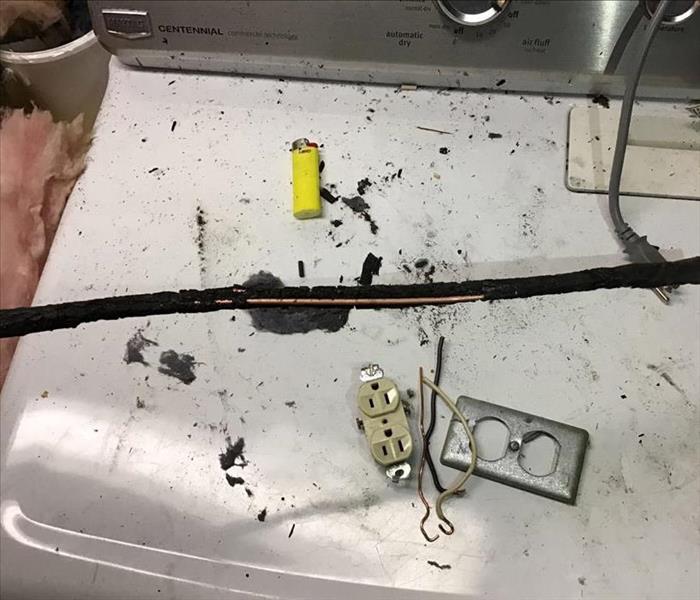 Lint is highly flammable. Clean out your dryer vent.
Lint is highly flammable. Clean out your dryer vent.
Fall is here and Winter is coming so we all know that we Iowan folks are going to use fire very soon whether it is to light up a fire pit or chimney to warm up during the cool nights or light the pumpkin latte scented candle to fill our home with seasonal cheer. We need to make sure we are being very careful in order to keep our precious home safe. We want to take a moment to give you 5 tips on how you can prevent a fire.
5 Ways You Can Prevent Fires.
- Make sure you keep your stove and oven clean from grease, food and flammable cardboard or paper. Never leave the food you are cooking unattended.
- Be cautious when lighting candles. Make sure candles are clear from curtains or anything really and always remember to blow out the candle when you are leaving the room.
- Clean out your dryer vent and throw the lint away. Do not collect lint in your laundry room. If an electrical issue does occur, the lint is highly flammable and it will make matters worse.
- Be cautious of your space heater. Do not plug it in a power strip that is not designed for a higher voltage. Always unplug the space heater before you leave the house or go to bed.
- Keep your cords in good shape. If you have a pet that has chewed some cords, please change them out right away because this can be extremely hazardous.
DO YOU HAVE AN ESCAPE PLAN?
It’s not a joke. Escape plans or practicing your escape plan isn’t only for schools or businesses. The National Fire Protection Association has created a grid you can download and print to help you create an escape plan for you and your family. CLICK HERE to download.
Win a Fire Extinguisher from us!
During this Fire Prevention Week (Oct 6th – 0ct 12th), we are giving away a fire extinguisher for your home. There are three things you need to do in order to enter this giveaway. First, go to Facebook and LIKE our Fire Extinguisher post which will be the very top post. Second, Leave a comment! Lastly, Share the post. The last day to enter is Oct 12th, 2019 and the winner will be announced Wednesday, Oct 16th. Good luck!!
Smoke Cleanup at South Tama Middle School
8/7/2019 (Permalink)
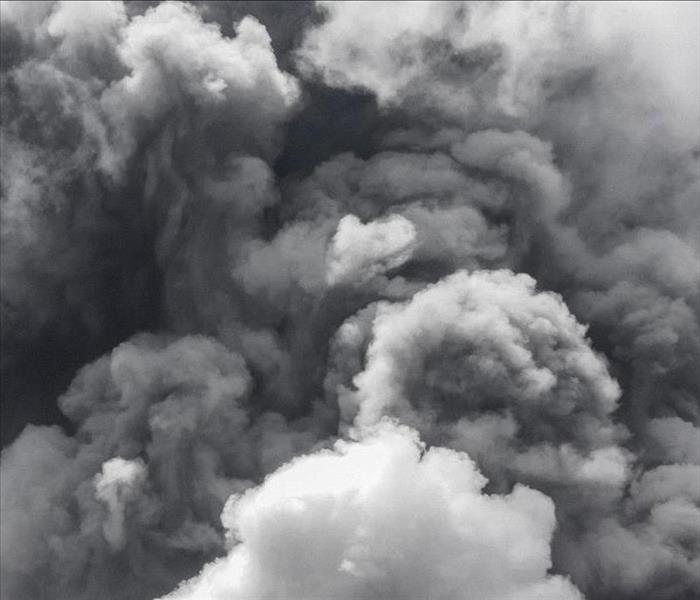 (Photo by Jens Johnsson on Unsplash) We are trained and equipped to remove soot and smoke odor after a fire.
(Photo by Jens Johnsson on Unsplash) We are trained and equipped to remove soot and smoke odor after a fire.
On August 5th, firefighters were called to South Tama Middle school in the middle of the night due to a fire. This fire originated in the boiler room which was located in the basement. Luckily the fire was contained. The school will receive a full smoke and odor clean up and some construction from SERVPRO of Cedar Rapids and us, SERVPRO of Black Hawk County.
LOCALLY OWNED BUT WITH A ONE TEAM MINDSET.
We received the call to be apart of this job a day after the incident from Co-Owner of SERVPRO of Cedar Rapids, Brett Kellogg. Our Owner Scott Demuth and Production Manager Brett Armfield quickly took off to Toledo, IA to assist in the full inspection of the fire damage. We are truly excited to be working as ONE TEAM with another franchise. This job may seem overwhelming to another cleanup and restoration business but not to SERVPRO! The school needs to be cleaned from top to bottom before August 16th, that means we only have 10 days to get this job done but we are ready and excited to meet the challenge. The team has taken the initiative to form a strategy to get South Tama Middle ready before their teacher’s planning day.
Here’s a low down on our plan.
- We have requested 20+ workers to help with the Cleanup process.
- We are setting up a tent for employee check-ins and equipment inventory.
- We are loading our truck with equipment and commercial cleaning products.
- We have 1-3 on-site supervisors making sure tasks are being met.
- We have employees removing tiles from the ceiling so we can remove smoke odor from all crevices.
- We are blasting soot or fire particles with a commercial garnet blaster.
- We are setting up various air movers on site.
- We will be in daily communications with the superintendent on our progress.
- We will clean every carpet in the building.
- We will do a full cleanup of the chimney.
Getting to the Finish Line with Ease.
Scott and Brett have a combined 11+ years of experience in restoration and cleanup services. We are eager to get this job done for the community and to continue building our brand as a business you can trust. For the next 2 weeks, our team will be working overtime to get this school looking “Like it never even happened.”
Get connected with us and follow us on INSTAGRAM or FACEBOOK. @SERVPRObhc
August 4th is Campfire Day - Celebrate with some Campfire Tips!
8/1/2019 (Permalink)
 Remember to fully extinguish your fire before leaving the campgrounds.
Remember to fully extinguish your fire before leaving the campgrounds.
Here in Iowa, we love campfires.
Even though it’s summer, the worst of the heat has ceased for a moment allowing us to enjoy our evening with 70-degree weather. School doesn’t start for another 3 weeks so enjoy the great outdoors with friends and family. Maybe visit Deerwood Park in Evansdale or Big Woods Lake in Cedar Falls? Wherever you decide to go camping, we want you to have loads of fun and to stay safe.
Here’s some Campfire Safety Tips! *
- Find out the campground rules about building a fire. Campgrounds may already have existing fire rings or pits.
- Make sure your fire pit is 15 feet away from dry logs, leaves or any flammable objects.
- Keep your fire to a manageable size.
- Never leave your campfire unattended.
- When extinguishing the fire, drown the fire completely in water until there is no more hissing.
- If there’s no water, allow all the wood to burn to ash and cover with dirt.
- Before leaving the campground, make sure the firepit is cool to the touch.
*For more information on Campfire Safety Tips, visit smokeybear.com.
Now that we know you’re going to stay safe during your camping trip, we are ready to blow your mind with a few Non-traditional Smores!
- Graham + Banana + PB + Marshmallow + Bacon
- Chocolate Graham + Mint Chocolate + Marshmallow
- Chocolate Chip Cookie + Hazelnut Spread + Strawberry + Marshmallow
- Oreo + Marshmallow (stick the marshmallow in between the sandwich cookie)
- Graham + PB cup + Marshmallow
Yum! We would love to hear about your campfire adventure on social media. Tag @SERVPRObhc in your photo or story and share your campfire safety practice.
FROM PANICKED TO PREPARED, SERVPRO of Black Hawk County's E.R.P can take you there.
7/24/2019 (Permalink)
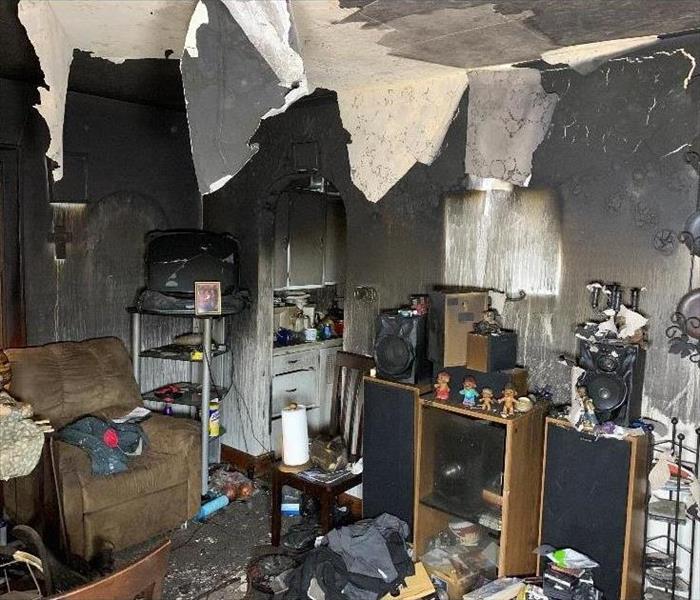 Unexpected things can happen, Do you have an Emergency Ready Plan?
Unexpected things can happen, Do you have an Emergency Ready Plan?
NO one is really ever ready for any kind of disaster! We can try to put measures in place that help us get on top of a situation, but in all honestly, it’s difficult to really get prepared on our own!
The no-cost to you EMERGENCY READY PLAN (ERP) is a pro-active approach to help streamline your efforts in putting your home back together.
House fires are devastating! SERVPRO of Black Hawk County can help you put a detailed action plan in place that can take you from panicked to prepared if you experience a fire in your home. Through a 20-minute question and answer time with a member of SERVPRO, a profile is put together that documents the following:
- Emergency contacts that include insurance agents, policy numbers (name, phone, email)
- Pictures of the main utility information: shut off locations for electric, gas, water
- Additional utility contact info: pictures of alarm systems, sprinkler, IT server
- Property overview –PICTURES of rooms and contents
- Additional notes for anything else homeowners may want
THERE’S AN APP FOR THAT!
The big plus is that the ERP IS AN APP and can be uploaded to your phone and home computer. Access it from anywhere! Working to develop this ERP does not obligate homeowners to SERVPRO in any way. (But we would come running if you called during an emergency to assist) J
We all know the plan for fire exits in our homes but we don’t usually have a plan to get back into our homes quickly! SERVPRO’s Emergency Ready Plans do that!
You may never feel prepared for a fire, but taking the steps to develop your personal ERP is a start. The Emergency Ready Plan creates confidence that you have, literally, at your fingertips the contacts and documented contents of your home to help rebuild after a fire in a speedy fashion.
We can devise an Emergency Ready Plan to protect your home from fire damage. Call us at (319) 268.1521 before a disaster occurs.
The ROOF is on Fire… Shingles VS Metal
7/6/2019 (Permalink)
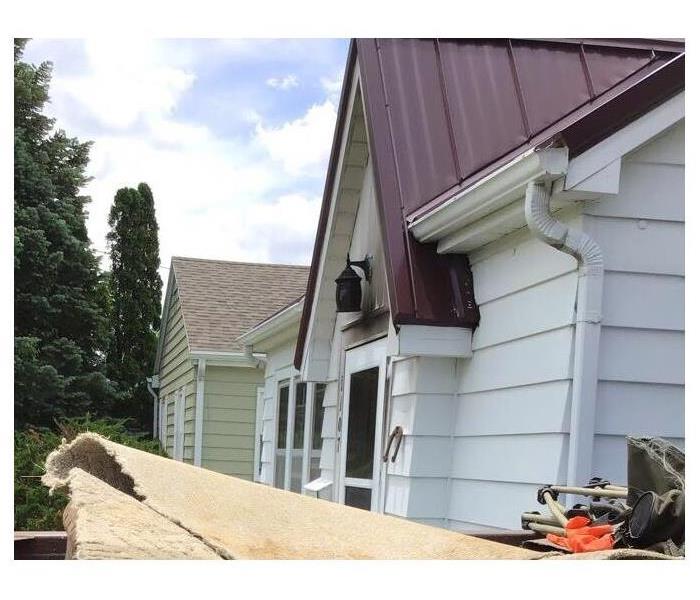 The red roof of a small home in Waterloo after a fire. No damage on the outside is noticeable except for the doorway where smoke tried to escape.
The red roof of a small home in Waterloo after a fire. No damage on the outside is noticeable except for the doorway where smoke tried to escape.
Do we have any HGTV fans out there?
Well, as a restoration company that works with a lot of homeowners, we tend to also be a fan. We are noticing the emergence of metal roofing, not only on our favorite home improvement show but in some of the houses that our production crew are working on. Recently, we had to do board-up of a home in Waterloo from a fire. This small home had a red metal roof. We started to wonder whether metal roofs may have added to the fire damage so we did a little research. Here are a few pros and cons that can help you make a well-informed decision on choosing what type of roof is best for your home.
Shingle Roof Pros:
- Asphalt shingles are very inexpensive and can possibly outweigh the price of a long-term metal.
- They tend to be easier to install and replace. Some can be installed within 1-2 days.
- It is less expensive to repair.
Shingle Roof Cons:
- Shingles usually need to be replaced every 12-17 years.
- If you live in your home for a long time it may be a higher long-term cost.
- It absorbs heat and performs poorly in extreme heat which can cause cracking.
Metal Roof Pros:
- It can last up to 50 years.
- Outperforms other roofs in its weathering as well as being non-combustible.
- It is environmentally friendly as it reflects heat helping keep the house cool and the energy bill low.
Metal Roof Cons:
- The cost can range from $150-$1,400 per square.
- Depending on the type of metal, they are more prone to denting.
- In the case of a fire that starts inside the home, it may be harder for firemen to cut through the roof to ease the fire. A fire department might not have the right equipment for metal roofing.
So, does a metal roof increase fire damage in a home?
Not necessarily...A house fire is dangerous and will cause damage no matter the roof your home has. Firefighters who are well equipped and well trained can help stop the fire at home but unfortunately, your home may suffer from smoke and soot damage as well as smoke odors.
We can help restore your home and belongings after a fire. Call us at (319) 268-1512.
Sources:
https://www.sheffieldmetals.com/Resources/Blog/metal-roofing-vs-shingle-roofing
https://www.hometips.com/buying-guides/metal-roofing-drawbacks.html
https://www.metalroofing.systems/metal-roofing-pros-cons/#longevity
The Terrifying Truth about Laundry
6/16/2019 (Permalink)
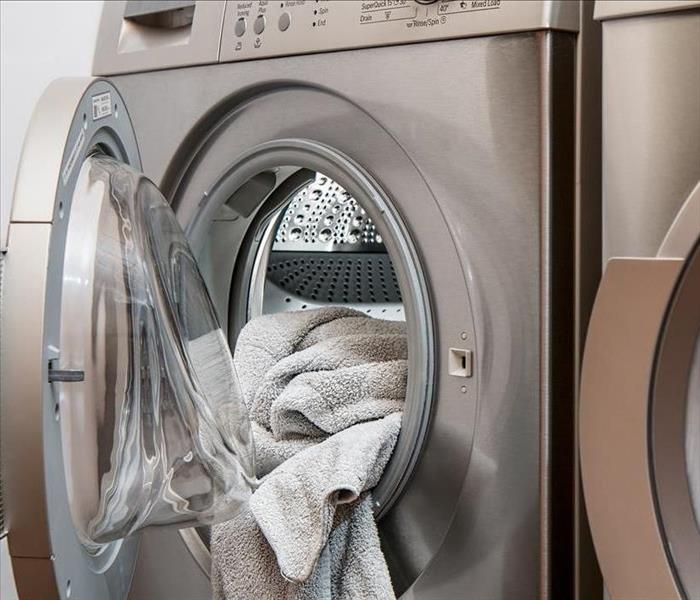 Don't let your laundry become an absent-minded activity. It needs more attention and supervision than you realize.
Don't let your laundry become an absent-minded activity. It needs more attention and supervision than you realize.
Most of us pride ourselves for being incredibly talented multi-taskers, going through life and getting stuff done. That’s great and all, but there comes a time where it’s actually dangerous to multi-task. For instance, laundry is not something you want to do while you’re away from home because two major disasters can happen the minute you leave your home.
Water Loss Potential
The first one being a water loss when your washing machine’s water line breaks or starts leaking. Another possibility is the hose hooked up to your washer can actually become detached due to the shaking and shifting of the machine. Wouldn’t that be a fun surprise to come home and see your entire laundry room floor is covered in water? Actually, no. It’s not fun. We would know.
Fire Loss Potential
The second major disaster that is likely to occur is a fire sparking from the clogged lint in your dryer vent. With fires being so unpredictable, we strongly advise you do not hit the start button before you run some errands in town. An extra precaution we advise is cleaning out your lint trap before and after each use, and on a yearly basis, clean out the vent pipe or have a dryer lint removal service do it for you.
Lesson Learned
We know it’s tempting to get two things done at once, but this is one task that needs more of your attention and presence.
Spontaneous Combustion of Rags
4/13/2019 (Permalink)
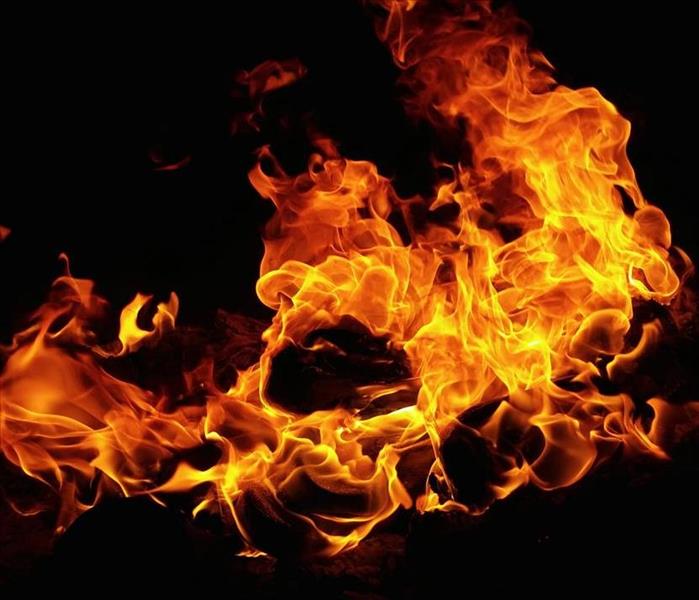 Spontaneous Combustion can cause serious fires if not attended to.
Spontaneous Combustion can cause serious fires if not attended to.
Have you ever heard of something catching fire out of the blue without being exposed to an open flame? Believe it or not, this can actually happen. It’s called a spontaneous combustion fire.
Tell Me More
In these cases, oil-soaked rags can slowly heat to their ignition point through a process called oxidation. The products that are at risk include oil-based paints and stains, teak oils, varnishes, paint thinners, etc. Heat will begin to release from the rags; however, if the heat cannot escape, the temperature will increase to a level high enough to ignite.
It can Happen to Anyone
SERVPRO of Black Hawk County has responded to several calls where the fire was caused by spontaneous combustion. The true danger is if the fire starts while you are away from your home. Damage can happen all too quickly when time is on a fire’s side.
Disposal
We encourage you to properly dispose of your rags after exposed to oily substances. The best method is to place the rags in a metal trashcan with a tightly fitted lid on top. You can then fill the remaining space in the trashcan with water to prevent the rags from heating up. However, this is a temporary solution. The long-term answer is to wash the rags in a hot cycle as soon as possible.
Hopefully, you will never experience such an occurrence, but if there is a necessity for clean up after a fire, know that SERVPRO of Black Hawk County can assist you!
Additional Source: https://www.bendoregon.gov/
Christmas Tree Safety
1/2/2019 (Permalink)
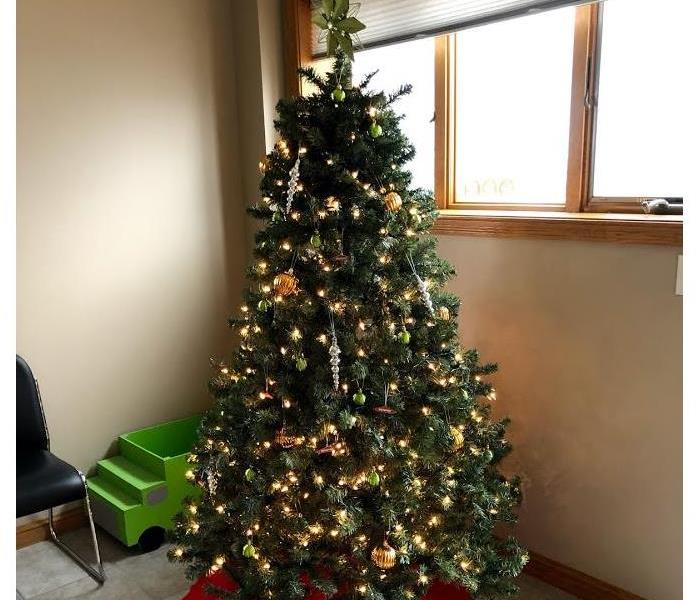 We're taking our advice and are putting away our office tree for the year.
We're taking our advice and are putting away our office tree for the year.
With the holidays coming to an end, we want to encourage you to dispose or store your Christmas tree sooner rather than later. The reason being it’s a fire hazard, regardless if you have a real or artificial tree, and the dryer the tree, the bigger the fire hazard. In fact, nearly 40% of U.S. home fires that begin with Christmas trees occur in January.
In light of the holiday season winding down, we’d like to give you a list of tips to consider when getting your tree next holiday season.
1. Fresh is best: Buy a tree that isn’t previously cut to prevent it from drying out before you bring it home.
2. Do your research: If you have a pre-lit artificial tree, check to see if it’s been recalled. Often times, these kinds of trees are recalled due to exposed wiring and electrical shock hazards.
3. Hydration is key: Keep your tree well-watered throughout the entire holiday season to keep your tree green and fire free.
4. Lights out: Don’t leave lights plugged in when you leave your home or go to bed. If a fire sparks, you want to be the first to know.
5. Flames lead to blame: Keep open flames, such as candles, away from the tree at all times.
6. Your outlets need breaks too: Don’t overload your electrical sockets when plugging in Christmas tree lights.
Disposal of Ashes
8/13/2018 (Permalink)
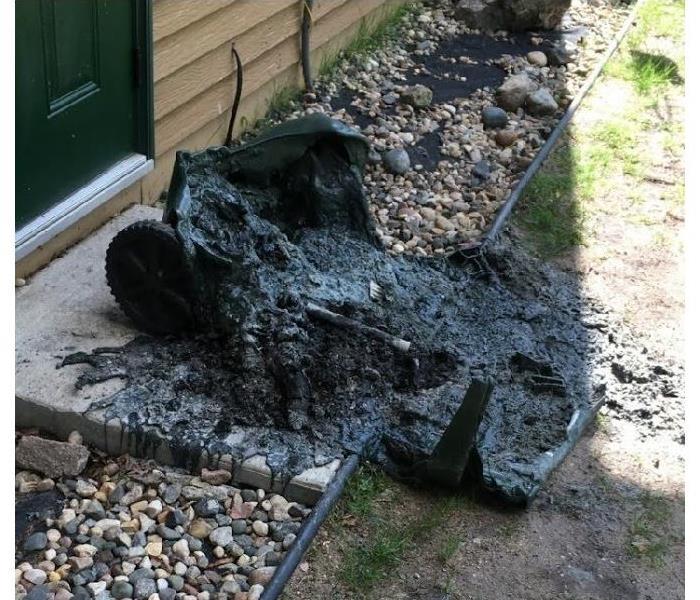 WARNING: Do not put ashes in a plastic trash can. We know from personal experience that it does not end well.
WARNING: Do not put ashes in a plastic trash can. We know from personal experience that it does not end well.
As the end of summer draws near, we’d like to address the proper way to dispose of any left-over ashes you may have sitting in your fire pit.
Be Safe:
Always treat ashes as if they’re hot when removing them because they can stay hot for several days after the initial fire. It all depends on the heat of the fire and what was burned.
Proper Disposal:
- Wait several days after a fire to remove the ashes—just to be safe
- Place the ashes in a metal trash can and dump some water on top
- Be sure the trash can is placed far away from anything that would catch fire such as a home, garage, or tree
- Keep the trash can away from any combustibles
What not to do:
The person who sent us these photos found out the hard way the improper way to dispose of ashes. Let’s walk through some basic techniques that should be avoided:
- Placing ashes in a trash can the day after a fire
- Using a plastic trash can for the disposal
- Having the trash can right next to the house
Thank goodness a friendly neighbor noticed the smoking trash can, or this could have been a more serious case. The only damage was to the trash can.
Timeline of Events:
The time-lapse of the destroyed trash can was within a 3-hour window. The ashes were placed at 1 pm, and the destroyed trash can was found at 4 pm.
Spread the Word:
This a mistake that is too easy to make, and that’s why we love to educate people. Please share this information, so no one makes the same mistake.
Source: https://www.portlandoregon.gov/
How to Put Out a Grease Fire
7/26/2018 (Permalink)
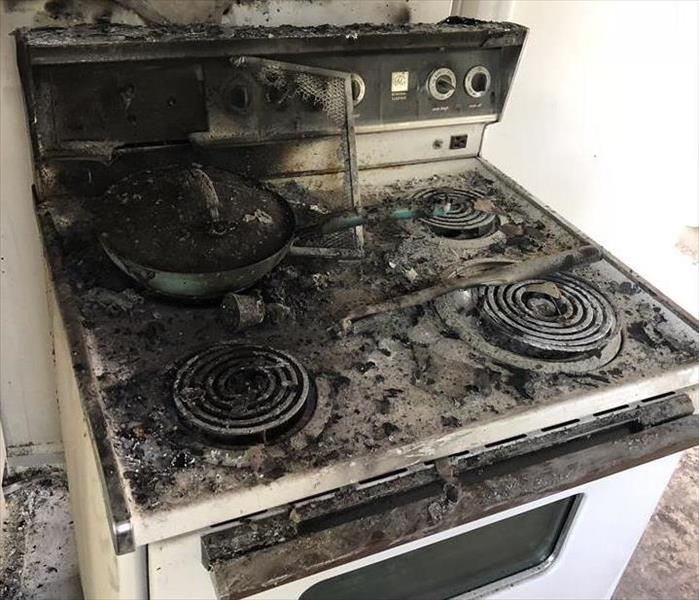 This is the aftermath of a grease fire.
This is the aftermath of a grease fire.
Fires are scary. Grease fires are even scarier because we have to fight off our human instinct to throw water on the blazing flames. Yes, you heard right. Do not throw water on a grease fire. It’ll only make the situation worse. Odds are, if you put water on the grease fire, it’ll A) make it bigger and B) spray grease all over you—which may lead to minor burns.
SERVPRO of Black Hawk County has been building awareness for several months now regarding the proper way to handle grease fires by handing out cans of baking soda. Here are steps to follow when dealing with a grease fire.
1. Get the Baking Soda
The number one way to put out a grease fire is sitting right in your kitchen: baking soda! That white powdery stuff works miracles in dowsing fires in your kitchen. We recommend keeping it in an easy-access area near your stove, but not right above your stove because tall flames can make it nearly impossible to grab in your moment of need.
2. Take Away Its Power
You should also turn off the source of heat as soon as possible. This will keep the fire from growing any bigger.
3. Grab the Lid
If the fire isn’t too big, you can also cut off the oxygen supply by putting a lid over the pan. Just be careful not to burn yourself in the process.
Again, do NOT pour water on a grease fire. It’s bad news.
We encourage you to educate young teens who are learning to cook about the dangers of grease fires, and as always, if you have any fire damage, give us a call. We’ll make it, “Like it never even happened.”
148 Emergency Response Guidlines
7/23/2018 (Permalink)
 Backed by 1,700 franchises- you can trust us.
Backed by 1,700 franchises- you can trust us.
We wait all the time. We wait in line. We wait for our food. We even wait for our packages to arrive in the mail. Well, the wait is over. SERVPRO of Black Hawk County is promising right here and now that you will not have to wait for us.
We acknowledge the importance of emergency response time by living by the 148.
1 – Within one hour from notice of loss, we will contact you to arrange for service
4 – Within four hours of loss of notification, we will be on-site to start mitigation services (if necessary).
8 – Within eight business hours, we will communicate with you what needs to be done and how we will take action.
So, when a water or fire emergency strikes—regardless of the time and day—give us a call. We’ll be there because we’ve got your back. It’s as simple as that.
We'll make it, "Like it never even happened."
5 Facts About Smoke Damage
7/9/2018 (Permalink)
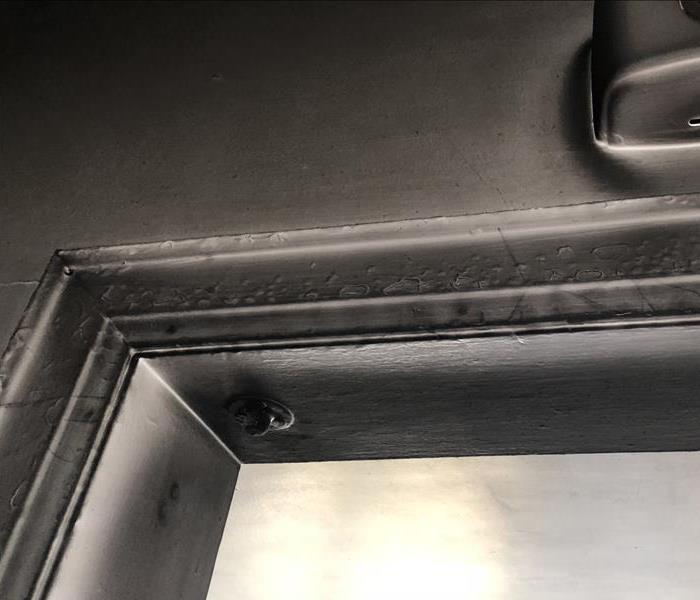 Smoke damage to a wall.
Smoke damage to a wall.
Smoke damage is often overlooked, but it’s more prevalent than one would think. Discover five facts about smoke damage, so you can be prepared for a fire loss.
This Stinks—Literally
The smell of smoke can remain long after the fire occurred. For this reason alone, we highly recommend people receive professional help from SERVPRO of Black Hawk County in any fire loss. We use deodorizers, air scrubbers, and fogging equipment to eliminate the smell of smoke.
If the smoky smell remains, it can actually impact the selling price of your home or business when you go to sell it.
Discoloration is Everywhere
Another burden of smoke damage is the discoloration. Walls, ceilings, household items, and more can be discolored after a fire. In the photo, you can see the walls have turned black due to excessive smoke—and no, it’s not a black and white photo.
Unsafe to your Health
As you have probably guessed, smoke damage is also bad for your health. Coughing is only the start, with respiratory problems to follow.
Speed is Key
Corrosion is the next thing to occur after a fire, and time is not your friend. With every day ash sits, more corrosion will occur.
Different Smoke Types Require Different Cleaning Methods
Perhaps the trickiest thing about smoke is there are different types, and each type requires a different cleaning method.
If you experience any smoke damage, call SERVPRO of Black Hawk County right away. We’ll make it “Like it never even happened.”
Phone Charger Shorted Causing Fire Damage
2/21/2018 (Permalink)
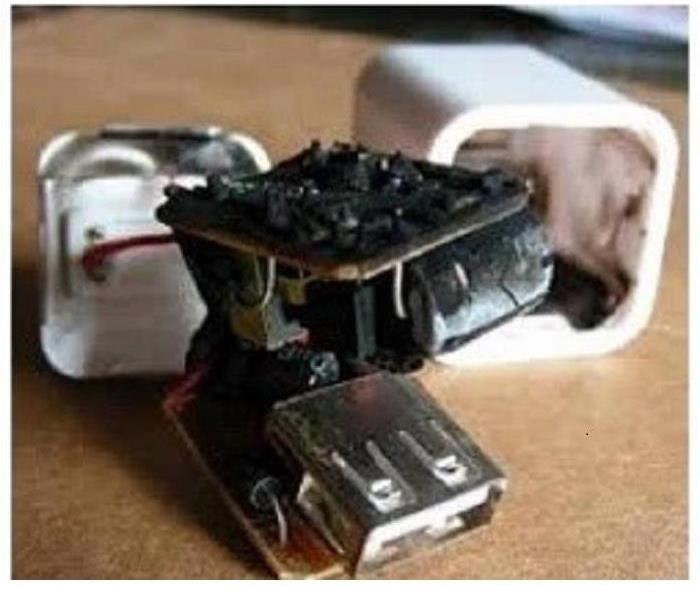 This is a phone charger that was plugged in and shorted out causing fire damage.
This is a phone charger that was plugged in and shorted out causing fire damage.
In a continuing education class presented by Todd Davis, Davis Agency Insurance, for SERVPRO of Black Hawk County, Todd pointed out that one fast growing fire hazard was phone chargers left plugged in for extended time periods. Look around, do you have one plugged in now and possibly without a phone attached?
To prove the point, I am sharing a story from SERVPRO of Dubuque, Iowa. They were recently called to clean up and rebuild a local home that sustained significant fire, soot and smoke damage due to an electrical fire.
As usual they were prevented from beginning their work until after the Cause and Origin Specialist had reviewed the scene and determined the cause of the fire.
It ended up in this case that a cell phone charger was left plugged in after the phone was removed after charging overnight. The charger shorted out and started a fire resulting in $50,000 plus in damage.
It is commonly known that charging a phone while on top of a flammable surface such as in bed or on a sofa is a fire hazard, but what about once the phone is removed from the charger?
Most people are unaware that once the phone or even the charging cord are disconnected there is still power being drawn by the "wall plug".
As we find that we use more and more mobile electronics in our daily lives, most of us have a handful of different chargers for our cell phones, tablets and other accessories. It is common to leave wall plugs or car chargers plugged in and simply disconnect our devices. Unfortunately doing so is not only a fire hazard but is becoming one of the most frequent causes of electrical fires in homes.
Two possible preventative measures are either simply unplugging all chargers when not currently in use or to plug all chargers into a quality GFI power strip and turn it off when not utilizing the chargers.
I hope this information will be helpful and can prevent a dangerous and costly fire in your home or business. Should you have a fire or water damage loss, please remember SERVPRO. We can make it "Like it never even happened."
Thank you to SERVPRO of Dubuque for sharing the picture and story.
Smoke and Soot Damage Can Cause a Pervasive Odor in Your Home!
5/25/2017 (Permalink)
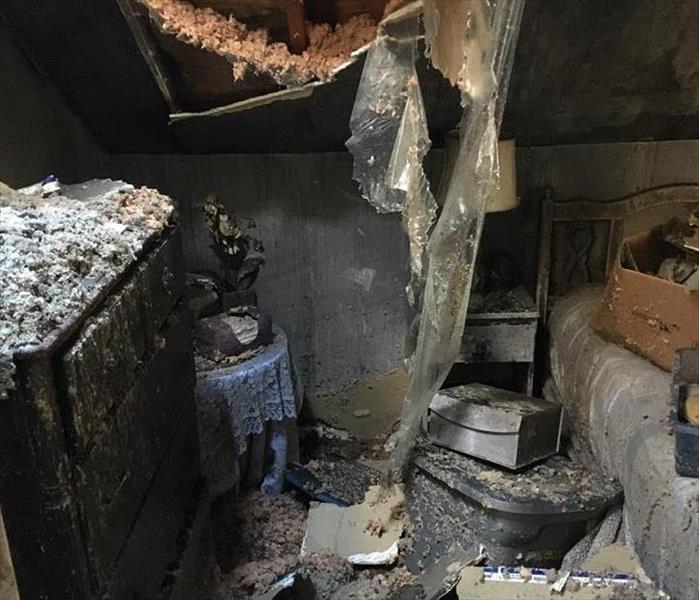 An upstairs fire that burned and smoldered within the roof destroyed this home. Materials like wet insulation add another layer of cleanup and odor.
An upstairs fire that burned and smoldered within the roof destroyed this home. Materials like wet insulation add another layer of cleanup and odor.
Smoke and soot is very invasive and can penetrate various cavities within your home, causing hidden damage and odor. Our smoke damage expertise and experience allows us to inspect and accurately assess the extent of the damage to develop a comprehensive plan of action.
Smoke and soot facts:
- Hot smoke migrates to cooler areas and upper levels of a structure.
- Smoke flows around plumbing systems, seeping through the holes used by pipes to go from floor to floor.
- The type of smoke may greatly affect the restoration process.
Different Types of Smoke
There are two different types of smoke–wet and dry. As a result, there are different types of soot residue after a fire. Before restoration begins, SERVPRO of Black Hawk County will test the soot to determine which type of smoke damage occurred. The cleaning procedures will then be based on the information identified during pretesting. Here is some additional information:
Wet Smoke – Plastic and Rubber
- Low heat, smoldering, pungent odor, sticky, smeary. Smoke webs are more difficult to clean.
Dry Smoke – Paper and Wood
- Fast burning, high temperatures, heat rises therefore smoke rises.
Protein Fire Residue – Produced by evaporation of material rather than from a fire
- Virtually invisible, discolors paints and varnishes, extreme pungent odor.
Our Fire Damage Restoration Services
Since each smoke and fire damage situation is a little different, each one requires a unique solution tailored for the specific conditions. We have the equipment, expertise, and experience to restore your fire and smoke damage. We will also treat your family with empathy and respect and your property with care.
Have Questions about Fire, Smoke, or Soot Damage?
Call Us Today – 319-268-1521





 24/7 Emergency Service
24/7 Emergency Service





























